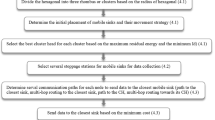Abstract
Mobile sinks in wireless sensor networks have been the target of extensive research recently due to their efficient energy consumption and various possible applications. To support mobile sinks, an energy efficient routing protocol is essential. In this light, the present study proposes a milestone-based predictive routing protocol that improves energy efficiency. This study introduces the concept of a milestone node, which plays a role of spreading the estimated sink’s future location information to the nodes located in the vicinity of the recent trail of the sink, and by using this information, nodes can route data packets to the mobile sink efficiently. Along with the proposed predictive routing protocol, this study also suggests a periodic broadcast scheme to provide the sink’s location information to the entire network in order to increase the data packet delivery ratio. Simulation results show that the proposed routing protocol reduces energy consumption while maintaining high data packet delivery ratios compared to previous routing protocols such as ALURP and Elastic.















Similar content being viewed by others
References
Lambrou TP, Panayiotou CG (2009) A survey on routing techniques supporting mobility in sensor networks. In: Proceedings of 5th international conference on mobile ad-hoc and sensor networks, Fujian, China, pp 78–85
Akyildiz IF, Su W, Sankarasubramaniam Y, Cayirci E (2002) Wireless sensor networks: a survey. Comput Netw 38(4):393–422
Kim HS, Abdelzaher TF, Kwon WH (2003) Minimum-energy asynchronous dissemination to mobile sinks in wireless sensor networks. In: Proceedings of the 1st international conference on embedded networked sensor systems, Los Angeles, CA, pp 193–204
Wang G, Cao J, Wang H, Guo M (2007) Polynomial regression for data gathering in environmental monitoring applications. In: Proceedings of 50th IEEE global communications conference, Washington, DC, pp 1307–1311
Chen C, Ma J, Yu K (2006) Designing energy efficient wireless sensor networks with mobile sinks. In: Proceedings of ACM sensys workshop WSW, Boulder, CO, pp 1–9
Luo J, Hubaux J-P (2010) Joint sink mobility and routing to maximize the lifetime of wireless sensor networks: the case of constrained mobility. IEEE/ACM Trans Netw 18(3):871–884
Rao J, Biswas S (2008) Data harvesting in sensor networks using mobile sinks. IEEE Wirel Commun 15(6):63–70
Karenos K, Kalogeraki V (2010) Traffic management in sensor networks with a mobile sink. IEEE Trans Parallel Distrib Syst 21(10):1515–1530
Gatzianas M, Georgiadis L (2008) A distributed algorithm for maximum lifetime routing in sensor networks with mobile sink. IEEE Trans Wirel Commun 7(3):984–994
Gandham SR, Dawande M, Prakash R, Venkatesan S (2003) Energy efficient schemes for wireless sensor networks with multiple mobile base stations. In: Proceedings of 46th IEEE global telecommunication conference, San Francisco, CA, pp 377–381
Kim T, Seo S, Chong PK, Kim Y, Yoo S-E, Kim D (2008) Experiments on mobile sink application in ZigBee networks. In: Proceedings of 12th IEEE international symposium on consumer electronics, Faro, Portugal, pp 1–4
Kusy B, Lee H, Wicke M, Milosavljevic N, Guibas L (2009) Predictive QoS routing to mobile sinks in wireless sensor networks. In: Proceedings of information processing in sensor networks, San Francisco, CA, pp 109–120
Shah D, Shakkottai S (2007) Oblivious routing with mobile fusion centers over a sensor network. In: Proceedings of 26th IEEE international conference on computer communications, Anchorage, AK, pp 1541–1549
Ye F, Zhong G, Lu S, Zhang L (2005) Gradient broadcast: a robust data delivery protocol for large scale sensor networks. Wirel Netw 11(3):285–298
Wang G, Wang T, Jia W, Guo M, Li J (2009) Adaptive location updates for mobile sinks in wireless sensor networks. J Supercomput 47(2):127–145
Ye F, Luo H, Cheng J, Lu S, Zhang L (2002) A two-tier data dissemination model for large-scale wireless sensor networks. In: Proceedings of 8th international conference on mobile computing and networking, Atlanta, GA, pp 148–159
Lee J, Yu W, Fu X (2008) Energy-efficient target detection in sensor networks using line proxies. Int J Commun Syst 21(3):251–275
Yu F, Park S, Lee E, Kim S-H (2010) Elastic routing: a novel geographic routing for mobile sinks in wireless sensor networks. IET Commun 4(6):716–727
Yu J, Jeong E, Jeon G, Seo D-Y, Park K (2011) A dynamic multiagent-based local update strategy for mobile sinks in wireless sensor networks. In: Proceedings of 11th international conference on computational science and its applications, Santander, Spain, pp 185–196
Liang W, Luo J, Xu X (2010) Prolonging network lifetime via a controlled mobile sink in wireless sensor networks. In: Proceedings of 53rd IEEE global telecommunications conference, Miami, FL, pp 1–6
Yun YS, Xia Y (2010) Maximizing the lifetime of wireless sensor networks with mobile sink in delay-tolerant applications. IEEE Trans Mob Comput 9(9):1308–1318
Marta M, Cardei M (2009) Improved sensor network lifetime with multiple mobile sinks. Pervasive Mob Comput 5(5):542–555
Heinzelman WR, Chandrakasan A, Balakrishnan H (2000) Energy-efficient communication protocol for wireless microsensor networks. In: Proceedings of 33rd international conference on system sciences, Maui, HI, pp 20–30
Acknowledgements
This research was supported by Basic Science Research Program through the National Research Foundation of Korea (NRF) funded by the Ministry of Education, Science, and Technology (No. 2011-0022314).
Author information
Authors and Affiliations
Corresponding author
Rights and permissions
About this article
Cite this article
Shin, K., Kim, S. Predictive routing for mobile sinks in wireless sensor networks: a milestone-based approach. J Supercomput 62, 1519–1536 (2012). https://doi.org/10.1007/s11227-012-0815-5
Published:
Issue Date:
DOI: https://doi.org/10.1007/s11227-012-0815-5




